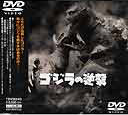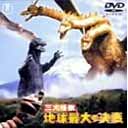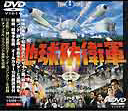| Release List | Reviews | Price Search | Shop | Newsletter | Forum | DVD Giveaways | Blu-Ray/ HD DVD | Advertise |
| Reviews & Columns |
|
Reviews DVD TV on DVD Blu-ray International DVDs Theatrical Reviews by Studio Video Games Features Collector Series DVDs Easter Egg Database Interviews DVD Talk TV DVD Talk Radio Feature Articles Columns Anime Talk DVD Savant HD Talk Horror DVDs Silent DVD
|
DVD Talk Forum |
|
|
| Resources |
|
DVD Price Search Customer Service #'s RCE Info Links |
|
Columns
|
 |
Article by Stuart Galbraith IVRandom Notes of a Region 2 Neophyte
|
||||
I had no intention of buying a DVD player in Japan - honest. With a shelf full of Japanese laserdiscs, I was adamant that I wouldn't be suckered into re-buying my collection of Japanese science fiction, fantasy and horror films, slapstick comedies, musicals, and occasional art house films all over again. But a recent trip to Japan last November and December, to some degree at least, changed my mind. Laserdiscs were always bigger in Japan than they ever were in the States. If you were a fan of Irwin Allen's TV shows, Britain's Thunderbirds series, or rarities like Disney's suppressed Song of the South, LDs imported from Japan were the only way to see them. I was first drawn to Japanese laserdiscs by the availability of Japanese science fiction: Godzilla, Rodan, Mothra, et al. Seeing films like Gorath (1962), King Kong vs. Godzilla (1962), Atragon (1963) and many others in crisp, widescreen presentations, in their original languages (and, infrequently, in full stereo) was a revelation, almost like seeing them for the first time. As my interest in Japanese film widened (and I had all but exhausted the sci-fi/fantasy mine), I was drawn to other films; other genres I noticed during trips to Tokyo in 1994, '95, and '99, including such offbeat titles as The Crazy Cats Go to Hong Kong (1963); Snow Trail (1947), Toshiro Mifune's screen debut, co-scripted by Akira Kurosawa; and You Can Succeed, Too (1964), a kind of Japanese How to Succeed in Business Without Really Trying. But there was one big caveat to all this: Japanese laserdiscs were not cheap, most labels charged around �3,800 per disc, and Toho, the company behind Godzilla & Company, charged top dollar for their titles, typically �6,000. With the exchange rate at the time, that came to about $60 per disc, and if you had a third party import it for you, you could easily tack on another $30-35 to that. And, of course, none of these high-priced discs had English subtitles. My initial optimism for Japanese DVDs was dampened by the gradual realization that the situation would not be all that different from the laser days: expensive discs, no subtitles, now coupled with the added frustration of region encoding. Indeed, it was if the Japanese film industry decided they didn't want their movies to be seen outside Japan. Consciously or no, Hong Kong movies found both a cult audience and a kind of mainstream acceptance (in terms of Jackie Chan and Crouching Tiger, Hidden Dragon anyway) partly because their movies trickled here in the 1980s and early '90s via Hong Kong laserdiscs that, by and large, were English-subtitled. And it continues, too, in the form of DVDs that are subtitled, often in myriad languages, and are without region encoding. Take, for instance, Kinji Fukasaku's instant cult film Battle Royale (2000). With its flawless 16:9 transfer and loads of extras (including an alternate ending), the Japanese DVD is far above the Hong Kong VCD, which has neither - but it is subtitled and inexpensive, and for most Americans that makes all the difference. Yet, when I began prowling DVD stores in Kyoto, Osaka, and Tokyo in November and December, I was surprised at A) how quickly DVD had supplanted laserdiscs since my last trip in 1999; B) just how many DVDs actually did have English subtitles, and C) the amount of American product available in Japan but not in America. 
For starters, DVD is everywhere. Because of the popularity of laserdiscs, DVD supposedly took longer to take off in Japan than it did here, but by last November anyway, the laserdiscs I found were largely delegated to the bargain bin. (Indeed, if you're the type who refuses to give up on laser, now's the time to make that shopping expedition to Japan; even box sets are dirt cheap.) I spent the first part of my trip on the small, southern Japanese island of Amami-Oshima, and was surprised to find DVDs even here, at the one video store on the island, one of a Tower Records-like chain called Tsutaya. This continued as I combed through bins of titles at Kyoto department stores, used record stores in Osaka, and the Japanese branch of Virgin Megastore in Tokyo. The next big surprise was the number of Japanese movies with English subtitles. The percentage is still quite low, maybe 10%, but nonetheless higher than I had anticipated. However, there is absolutely no consistency with what does get subtitled. A label like Shochiku will subtitle their goofy The X from Outer Space (Uchu daikaiju Girara, 1967), but not their popular and acclaimed "Tora-san" (1969-1995) film series, all of which were previously subtitled for limited theatrical screenings in America. Both the original and more recent Gamera films have been subtitled by Toshiba/Daiei Video, but none of Toho's Godzilla movies. Kon Ichikawa's excellent Dora Heita (2001), has been subtitled, but a new Kon Ichikawa boxed set has not. A picture as obscure as Nobuo Nakagawa's 1960 Shintoho film Hell (Jigoku, 1960) has subtitles, but Shintoho's similarly packaged line of war movies are without. Go figure. My surprise extended to DVDs of American TV shows available in full-season boxed sets as yet unreleased here. The entire run of ER, for instance, including the past season in 16:9 format, is available with both Japanese-dubbed and original English tracks, with removable Japanese subtitles. You like Friends? Ally McBeal? They're available, too, all reasonably priced. Though infrequent, I also encountered American movies not yet released to DVD, or released in better masters. For instance, I found a DVD of King Kong (1933), a title long-in-coming from Warner Home Video; and the original Planet of the Apes (1968) with a 16:9 transfer, something fans have been crying for since its inadequate non-anamorphic release here nearly two years ago.
|
||||
With one exception: Toho Video's transfers have been, to put it kindly, inconsistent. I picked up Toho's Frankenstein Conquers the World (1965) and King Kong vs. Godzilla (1962), for example, and while Frankenstein's transfer is okay (if a notch below Daiei's pristine Gamera films), King Kong vs. Godzilla looks like kaiju dung. Very likely it is they used the same transfer as the laserdisc, albeit 16:9'd. And as was true of their laserdiscs, Toho Video remains the industry's most frustrating label. Just as their laserdiscs had retail prices 20-30% above everyone else, so too is it with DVD. Most of their 2001 releases were priced at �6,300. (With the present exchange rate, about $47), compared with �5,040 ($38) for Hell and �4,935 ($37) for one of the Gamera films. Considering their pricing, lack of English subtitles or even substantial extras (most are carried over from the laserdisc), Toho Video has a long way to go to win the confidence back of many of their loyal laserdisc customers. Toho aside, the DVD market in Japan has come a long way in just a few short years. Perhaps if their English-subtitled titles sell relatively well, more will be in the offing, and the video market for Japanese cinema can at last take the foothold it so richly deserves.
|
||||
|
| Coming Soon |
|
|
| Special Offers |
|
|
| Columns |
| Home | Release List | Coupons | Shop | Reviews | Forum | Video Games | Price Search | Advertise |











